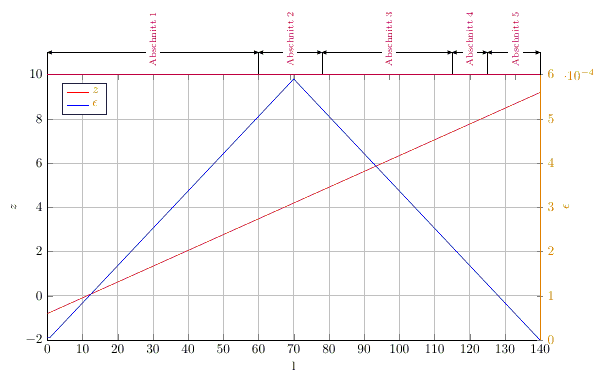|
Du setzt das m.E. an Stellen relativ codeintensiv um.
Hinweis: Damit man die Achsen unterscheiden kann habe ich sie farbig gemacht. Zum Problem: Das Problem der schlecht gesetzten Zehnerpotenz rührt von dem Stern in % Problem ======================= %axis y line*=right,% vermeidet Achsenpfeil, aber setzt Zehnerpotenz ungünstig axis y line=right, % setzt Zehnerpotenz gut, aber erzeugt Achsenpfeil axis line style={-}, % beseitigt Achsenpfeil % ============================= \documentclass{article} \usepackage{tikz} \usetikzlibrary{backgrounds} \usetikzlibrary{arrows} \usepackage{pgfplots} \pgfplotsset{compat=newest, % Globale, gemeinsame Schlüssel label style={font=\small}, width=13cm, height=7cm, % optional, bei Bedarf auskommentieren %at={(0,0)}, % kein Effekt } \begin{document} \begin{tikzpicture}[ >=stealth', ] \begin{axis}[ scale only axis, axis y line*=left, xmin=0, xmax=140, ymin=-2, ymax=10, xlabel={l}, ylabel={$z$}, xmajorgrids, ymajorgrids, ] \addplot [color=red] table[row sep=crcr]{ 0 -0.808648568650824\\ 140.01 9.1935736290271\\ }; \label{plot_one} \end{axis} % 2. y-Achse \begin{axis}[orange, % auskommentieren! scale only axis, % Problem ======================= %axis y line*=right,% vermeidet Achsenpfeil, aber setzt Zehnerpotenz ungünstig axis y line=right, % setzt Zehnerpotenz gut, aber erzeugt Achsenpfeil axis line style={-}, % beseitigt Achsenpfeil % ============================= axis x line=none, % ergänzt xmin=0, xmax=140, ymin=0, ymax=0.0006, xticklabels=none, ylabel={$\epsilon$}, legend style={at={(0.03,0.97)}, anchor=north west, legend cell align=left, align=left, draw=white!15!black} ] \addlegendimage{/pgfplots/refstyle=plot_one}\addlegendentry{$z$} \addplot [color=blue] table[row sep=crcr]{ 0 5.27610580989668e-06\\ 0.707121212121212 5.30333721330517e-06\\ 70 0.00059\\ 140.01 -6.94394699371304e-07\\ }; \addlegendentry{$\epsilon$} \end{axis} % 2. x-Achse mit Annotationen und Bemaßungspfeilen \begin{axis}[purple, % auskommentieren! clip=false, % notwendig scale only axis, axis y line=none, axis x line*=top, xmin=0, xmax=140, ymin=-2, ymax=10, % verlangt xtick={30, 69, 97, 120, 133},% xticklabels={Abschnitt 1 ,Abschnitt 2, Abschnitt 3, Abschnitt 4, Abschnitt 5}, xticklabel style={ anchor=west, font=\scriptsize, rotate=90, draw=none, inner sep=3pt, xshift=3pt, fill=white, }, ] \begin{scope}[on background layer] \foreach \u/\v in {0/60, 60/78, 78/115, 115/125, 125/140}{%% <---- Wertepaare überprüfen! \edef\temp{ \noexpand\draw[<->] (\u,11) -- (\v,11); \noexpand\draw[] (\u,10) -- (\u,11); \noexpand\draw[] (\v,10) -- (\v,11); }\temp }%% \end{scope} \end{axis} \end{tikzpicture} \end{document} |
Folgen dieser Frage
Per E-Mail:Wenn sie sich anmelden, kommen Sie für alle Updates hier in Frage
Per RSS:Markdown-Grundlagen
- *kursiv* oder _kursiv_
- **Fett** oder __Fett__
- Link:[Text](http://url.com/ "Titel")
- Bild?
- nummerierte Liste: 1. Foo 2. Bar
- zum Hinzufügen ein Zeilenumbruchs fügen Sie einfach zwei Leerzeichen an die Stelle an der die neue Linie sein soll.
- grundlegende HTML-Tags werden ebenfalls unterstützt
Frage-Themen:
gestellte Frage: 25 Feb '22, 13:36
Frage wurde gesehen: 3,818 Mal
zuletzt geändert: 28 Feb '22, 11:17


Benutze den Stil
y tick scale label style, den Du im Abschnitt 4.18.1 "All Supported Styles" der Dokumentation vonpgfplotsfindest.